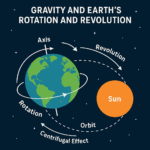
Understanding the Analemma: The Earth’s Path in the Sky

The analemma is a fascinating phenomenon that charts the sun’s position in the sky over the course of a year, creating a figure-eight pattern when observed at the same time each day from a fixed location. This post delves into the science behind the analemma, its significance, and its connection to Earth’s orbital mechanics.
What is an Analemma?
An analemma is a diagram that shows the position of the Sun in the sky as viewed from a fixed location on Earth at the same time of day throughout a year. The resulting shape is a figure-eight curve, which is a direct consequence of Earth’s elliptical orbit and the tilt of its axis. The analemma can be observed in various ways, such as in the positioning of sundials or in the path traced by the sun when photographed at regular intervals over a year.
The Science Behind the Analemma
The shape of the analemma is influenced by two key factors:
- Earth’s Elliptical Orbit: Earth’s orbit around the sun is not a perfect circle but an ellipse. This means that the speed at which Earth travels around the sun varies depending on its position in the orbit, causing the Sun’s apparent movement in the sky to speed up or slow down.
- Axial Tilt: Earth’s axis is tilted at an angle of about 23.5 degrees relative to its orbital plane. This tilt is responsible for the changing seasons and also contributes to the variation in the Sun’s position in the sky throughout the year.
Key Statistics:
- Axial Tilt: 23.5 degrees
- Eccentricity of Earth’s Orbit: 0.0167 (slightly elliptical)
Analyzing the Analemma
The analemma is most commonly depicted as a figure-eight, but its exact shape can vary depending on the observer’s latitude and the time of day the observations are made. The following grid provides a summary of the key factors that influence the shape and orientation of the analemma:
| Factor | Effect on Analemma |
|---|---|
| Latitude | Changes the tilt and height of the analemma |
| Time of Day | Alters the position of the analemma on the sky |
| Date | Affects the specific point on the analemma curve |
| Orbital Eccentricity | Influences the asymmetry of the figure-eight |
Historical Significance of the Analemma
The concept of the analemma has been known for centuries, with early astronomers using it to understand the irregularities in the solar calendar. The analemma was crucial in the development of accurate sundials and calendars, helping to account for the variation in the length of solar days throughout the year.
Notable Historical Facts:
- Ptolemy’s Analemma: The ancient Greek astronomer Ptolemy was one of the first to study the analemma in detail around the 2nd century AD.
- Sundials: Ancient sundials often incorporated the analemma to adjust for the equation of time, ensuring accurate timekeeping.
The Equation of Time
One of the most important concepts related to the analemma is the “Equation of Time,” which describes the difference between solar time (measured by the position of the sun) and clock time. This discrepancy arises because of the Earth’s elliptical orbit and axial tilt, leading to variations in the length of a solar day.
Equation of Time:
- Maximum Deviation: The equation of time can vary by as much as ±16 minutes over the course of a year.
- Solar Noon Variability: The time of solar noon (when the Sun is at its highest point in the sky) shifts throughout the year due to the equation of time.
Table: Equation of Time Deviation
| Date | Deviation from Mean Solar Time |
|---|---|
| February 11 | +14 minutes |
| June 14 | -3 minutes |
| November 3 | -16 minutes |
| December 25 | +4 minutes |
Observing the Analemma
For those interested in observing the analemma, the process requires patience and precise timing. By taking a photograph of the Sun at the same time and location every day for a year, you can create your own analemma. The shape and orientation of the analemma will provide insights into Earth’s orbit and axial tilt.
Tips for Observing:
- Consistent Timing: Ensure that observations are made at the exact same time every day.
- Fixed Location: Use a tripod or a fixed reference point to maintain consistency.
- Clear Skies: Observations require clear skies to capture the sun’s position.
Conclusion
The analemma is more than just a curious figure-eight in the sky; it is a visual representation of the intricate dance between Earth’s orbit and axial tilt. Understanding the analemma provides a deeper appreciation for the complexity of our planet’s motion and its impact on our perception of time. Whether you’re a seasoned astronomer or a curious observer, the analemma offers a unique way to connect with the cosmos.
Hello, I am Aman (: Full Time Traveler :) At the age of 41, in April 2023, fueled by my love for travel and the determination not to remain fixed like a tree, I embarked on a bold journey. Having dedicated 17 years to a corporate job, I chose to transition from a full-time employee to a full-time traveler, driven by the desire to break free from the routine and constraints of a conventional life. Along the way, I not only explored the wonders of travel but also uncovered the transformative power of financial freedom. I realized how it could liberate me to lead a life teeming with adventure, purpose, and fulfillment. Through my blogs, I am passionately sharing my story, aiming to inspire and provide valuable guidance to those, like me, who aspire to weave travel into a life overflowing with limitless possibilities.





















Post Comment
You must be logged in to post a comment.